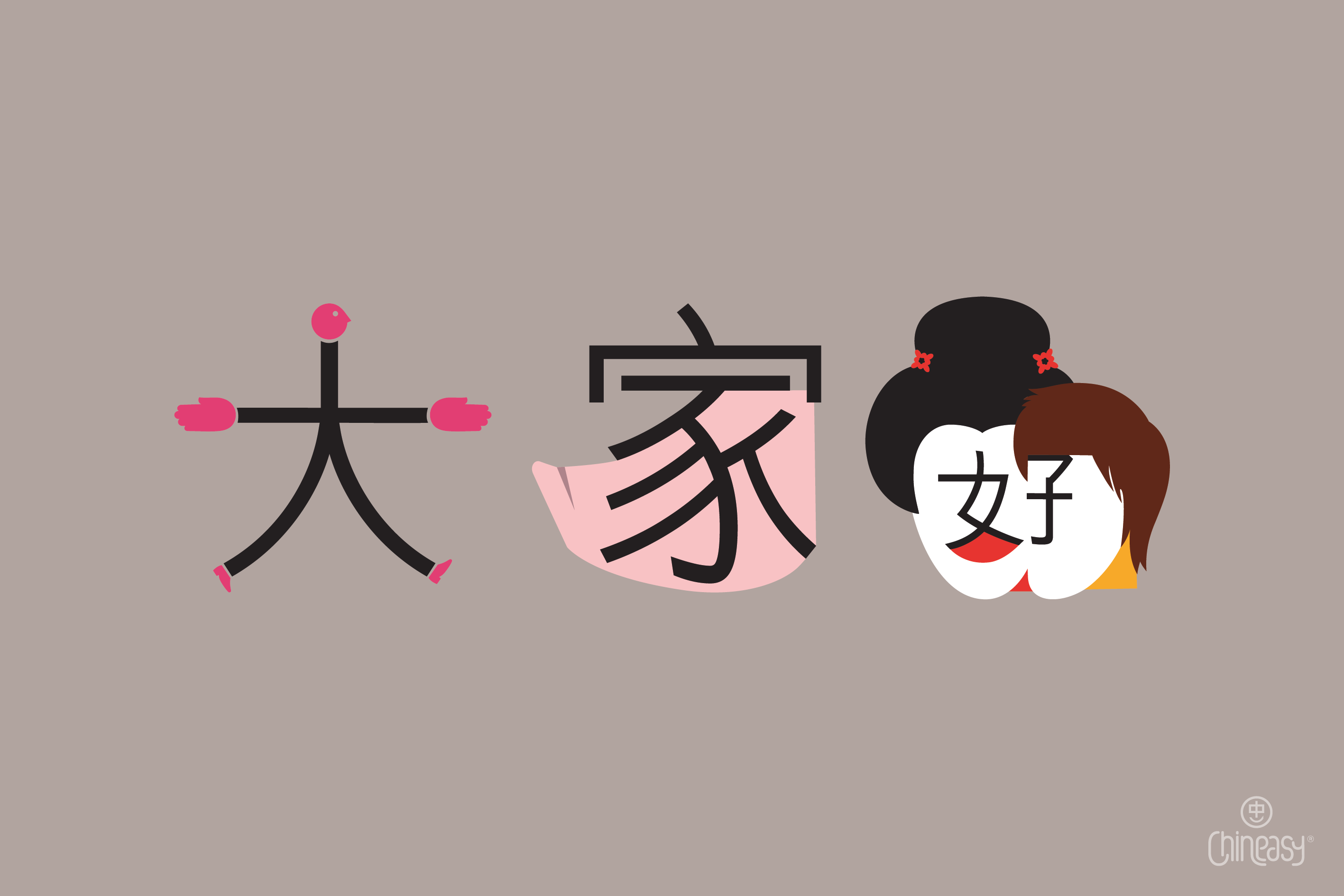Ever wondered why it’s a “biscuit” in the UK and a “cookie” in the US? It’s the same delicious treat, just with different names.
The British and Americans might have a laugh about these variations, but for non-native English speakers who are still learning English, it’s like juggling two languages at once!
This kind of mix-up isn’t just a quirk of English. Let’s leap into the world of Chinese, where even though the Mandarin spoken in China and Taiwan is generally the same, they have their special twists and turns—take talking about food, for instance.
So, in this post, we’ll dish out 10 food-related expressions where Chinese Mandarin and Taiwanese Mandarin part ways. These are the words that will give you an insider edge when chatting with your Chinese or Taiwanese pals. Ready to dive in? Let’s go!
Potato: 土豆 in China vs 馬鈴薯/马铃薯 in Taiwan
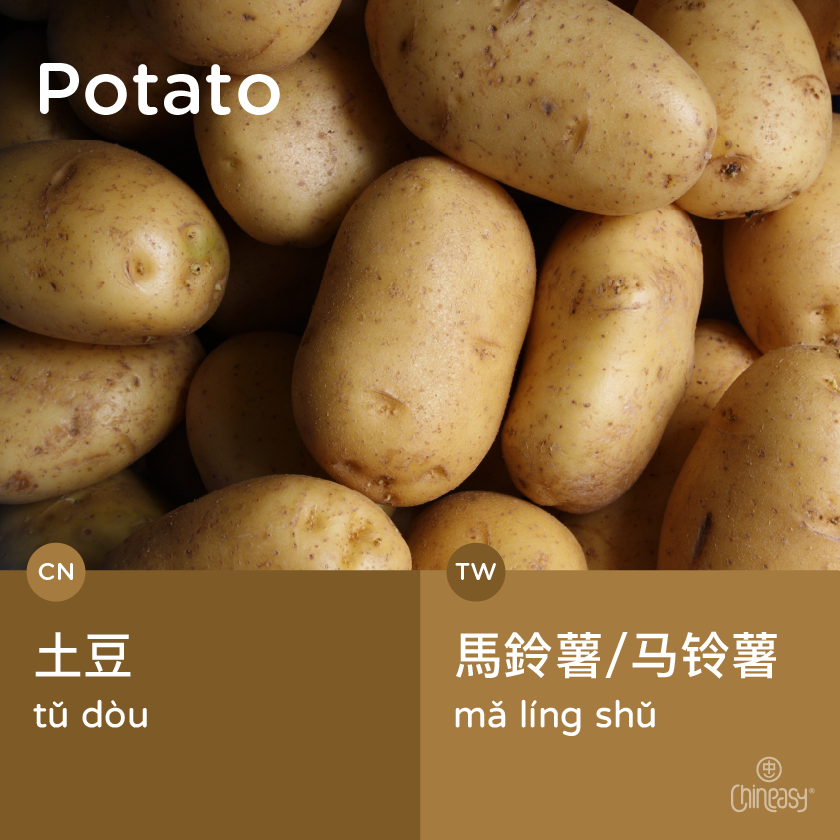
In China, if you’re craving potatoes, you’d ask for 土豆 (tǔ dòu), which is fondly referred to as “earth bean” because that’s where they come from—the soil.
Hop over to Taiwan, and potatoes are called 馬鈴薯 (mǎ líng shǔ), a term borrowed from the Japanese “jagaimo” which translates to “horse bell potato.” The simplified Chinese characters for this are 马铃薯.
Potatoes are a favorite in both places, no matter what name they go by. In China, there’s a beloved dish called 酸辣土豆絲/酸辣土豆丝 (hot and sour shredded potatoes; suān là tǔ dòu sī), where they slice the potatoes into thin strips and toss them in a zesty, spicy sauce. It’s a staple in many homes.
In Taiwan, a comforting classic is 馬鈴薯燉肉/马铃薯炖肉 (meat stew with potatoes; mǎ líng shǔ dùn ròu), a hearty dish that’s made extra special with the addition of 八角 (star anise; bā jiǎo), giving it a unique Taiwanese flavor.
These potato-based favorites are on the menu in many Chinese and Taiwanese restaurants. Just a tip: remember to order 土豆 when you’re in China and 馬鈴薯/马铃薯 in Taiwan if you’re looking to enjoy some delightful potato dishes.
Potato chips: 薯片 in China vs 洋芋片 in Taiwan
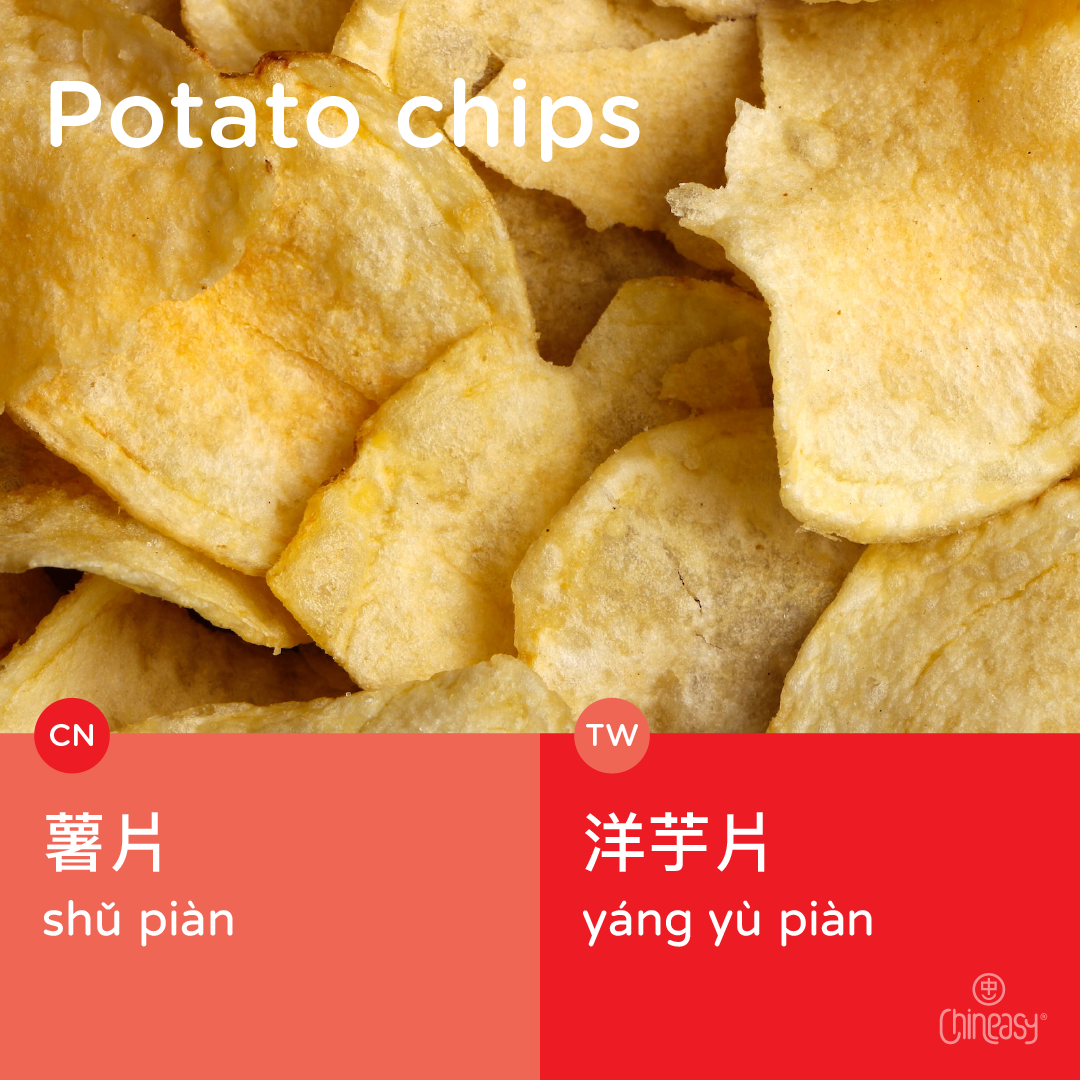
Think potato chips, and you imagine the crispy, salty bites that hit all the snack-time sweet spots: fat, salt, and starch. They’re a snack-time favorite not just anywhere, but also in China and Taiwan.
In China, reach for a pack of 薯片 (shǔ piàn): 薯 for potato as in 馬鈴薯/马铃薯 (mǎ líng shǔ), 片 means “slice.” Simple, yet so satisfying.
Take a trip to Taiwan, and the snack of choice is 洋芋片 (yáng yù piàn). Here, 洋 suggests something “foreign,” as potatoes are seen as an import, while 芋 nods to “taro,” likening the potato’s appearance to this well-known root vegetable. And 片 (piàn) again signifies a “slice.”
Wandering the snack aisles in China might surprise you with an array of unique flavors: lemon tea, cucumber, or even blueberry. Taiwan isn’t far behind with its own twist on chip flavors, offering seaweed, grilled prawn, and even savory salted egg varieties.
Whether you’re a fan of 薯片 or 洋芋片, one thing’s for certain—your taste buds are in for an adventure with the array of chip flavors awaiting on your next visit to China or Taiwan.
Instant noodles: 方便麵/方便面 in China vs 泡麵/泡面 in Taiwan
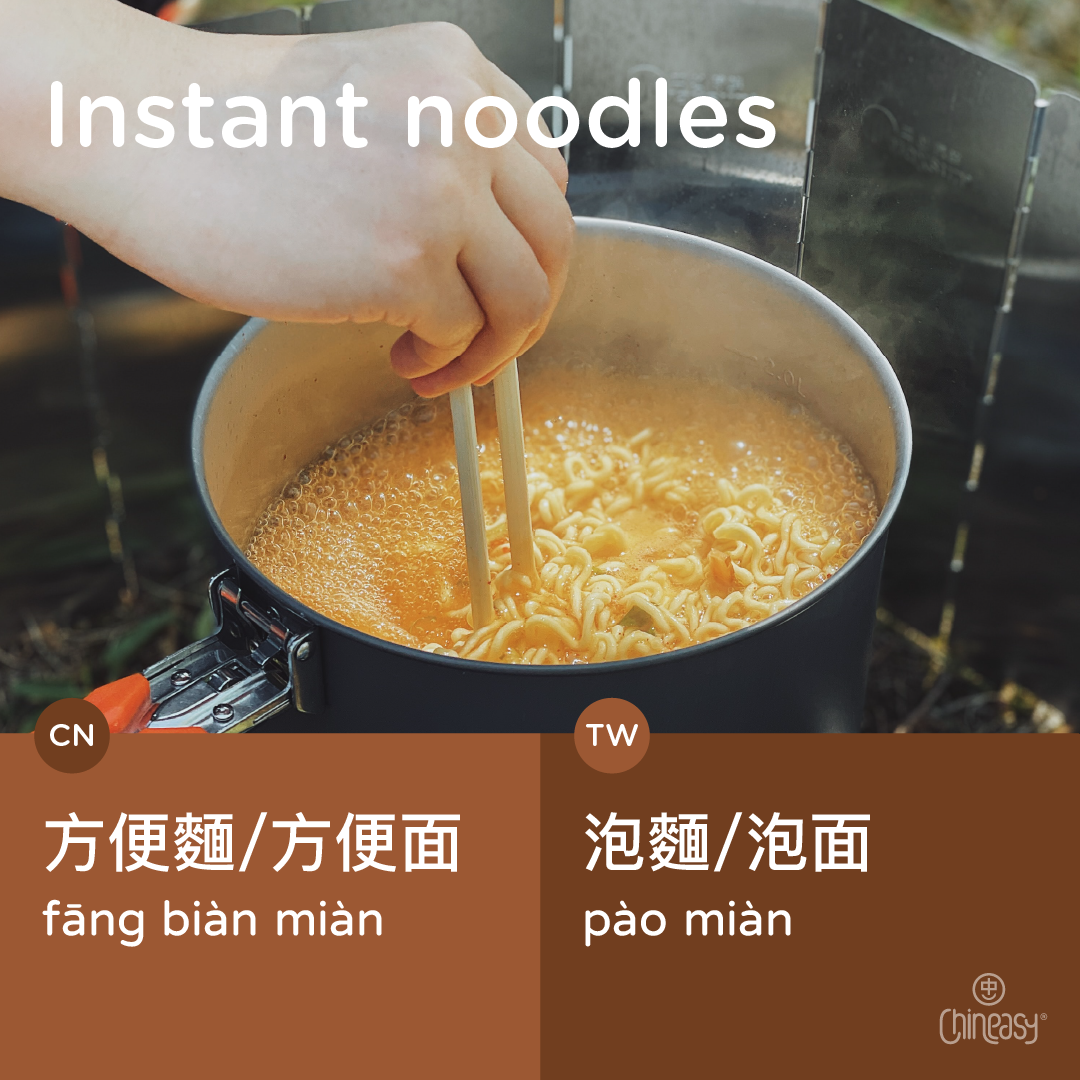
Who doesn’t love a good midnight snack? And when it comes to quick fixes, instant noodles are a top pick for many Chinese people. Easy to make and kind on the wallet, it’s no surprise they’re a mainstay in the cupboards of Chinese households.
In China, “instant noodles” are called 方便麵/方便面 (fāng biàn miàn), which literally means “convenient noodles”—and they’re exactly that. For those who are too busy or just can’t be bothered to cook, these noodles are a lifesaver.
Meanwhile, in Taiwan, they go by 泡麵/泡面 (pào miàn), or “soaked noodles,” because all you need to do is let them sit in boiling water—no stove needed.
Sure, instant noodles might not win any health food awards, but there are tricks to make them better for you.
In China and Taiwan, it’s common to throw in some veggies or an egg while cooking the noodles in a pot, boosting the nutrition. And if you’re watching your salt and calorie intake, just use less of the seasoning packet. A little tweak here and there, and voilà, you’ve upped the health factor of your speedy meal!
Ice cream: 冰激凌 in China vs 冰淇淋 in Taiwan
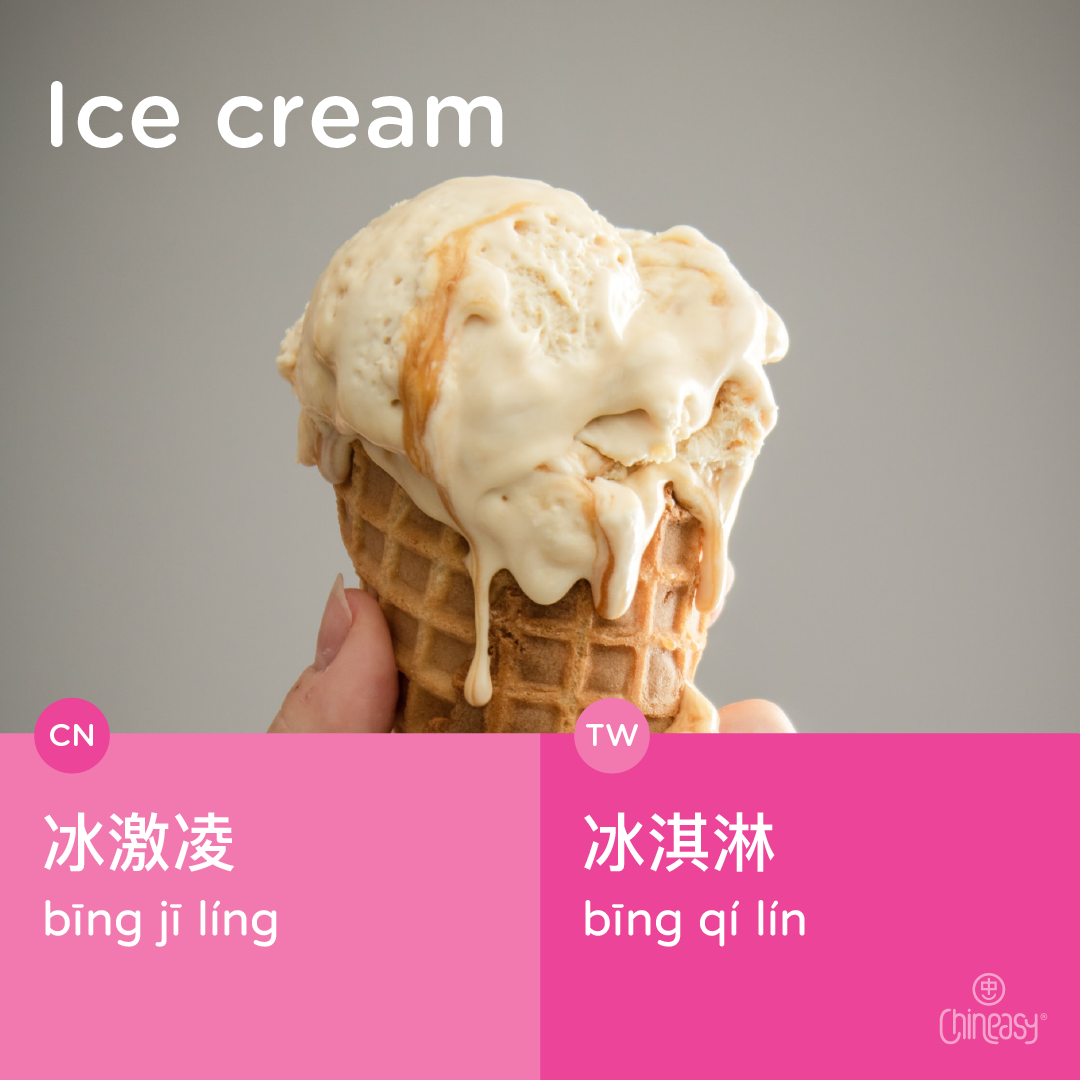
When craving something sweet and cold strikes, ice cream is the universal treat of choice. Enjoyed the world over, it satisfies the sweet tooth in China and Taiwan, too.
In China, you can indulge in the delight of 冰激凌 (bīng jī líng). 冰 translates to “ice,” perfectly capturing the cold nature of this dessert. The characters 激凌 parallel the English word “cream” more in sound than in meaning.
Make your way to Taiwan, and the frozen delicacy goes by 冰淇淋 (bīng qí lín). It begins with the familiar character 冰 (ice). The remaining characters 淇淋 (qí lín) phonetically echo 激凌 (jī líng).
So next time you’re looking to cool down and indulge in China or Taiwan, just remember whether it’s 冰激凌 (bīng jī líng) or 冰淇淋 (bīng qí lín) that will quench your craving to satisfy your desires with a scoop (or two) of icy bliss.
Yogurt: 酸奶 in China vs 優格/优格 in Taiwan

For those leaning towards a healthier snacking alternative, yogurt often tops the list. Rich in probiotics, it’s not just a delectable treat but also a boon for digestive health. In China and Taiwan, this dairy delight goes by two different names.
In China, when you’re in the mood for this tangy treat, you’ll ask for 酸奶 (suān nǎi). 酸 translates directly to “sour,” a fitting descriptor for the distinctively tart taste of yogurt, and 奶 means “milk,” indicating the product’s dairy origin.
Cross over to Taiwan, and the word for “yogurt” is 優格/优格 (yōu gé), a phonetic adaptation of the English word “yogurt.”
As both Chinese and Taiwanese societies become more health-conscious, yogurt’s popularity underscores a collective move towards foods that offer both health benefits and pleasing flavors.
Avocado: 牛油果 in China vs 酪梨 in Taiwan
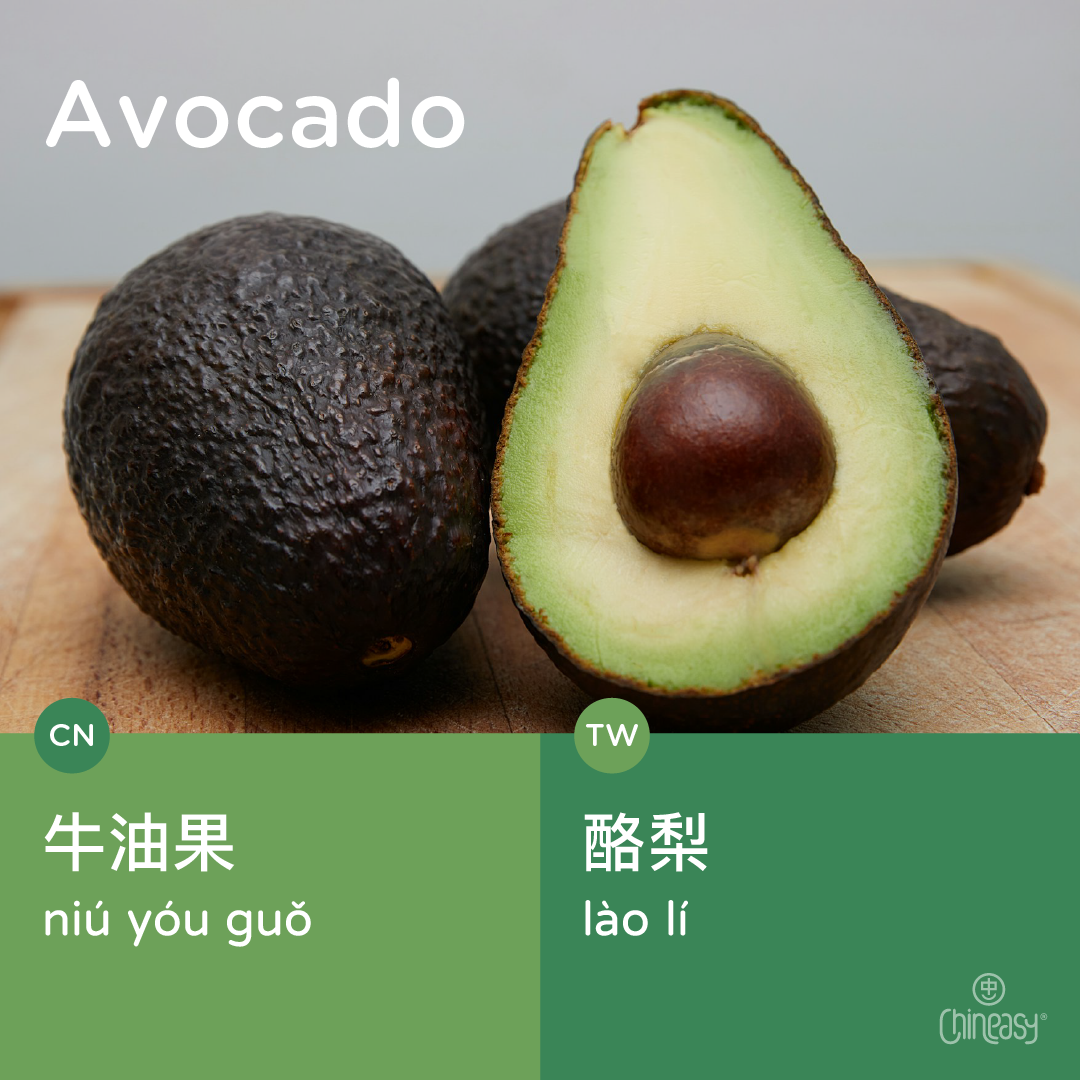
Avocado is becoming another top pick for health-conscious eaters in China and Taiwan, prized for its nutritional benefits.
In China, this creamy fruit is called 牛油果 (niú yóu guǒ), which translates to “butter fruit,” reflecting its rich, buttery texture that has captivated the taste buds of many.
Over in Taiwan, it goes by the name 酪梨 (lào lí), which means “cheese pear.” This term likely refers to the fruit’s creamy consistency that’s reminiscent of melted cheese, and its shape resembles a pear.
Recently, avocados have risen in popularity in both regions thanks to their versatility and health perks.
The locals enjoy them in salads, mashed on toast, whipped into smoothies, or as a creamy addition to omelets and pasta, showcasing their ability to enhance both flavor and nutrition in everyday meals.
Cheese: 芝士 in China and 起司 in Taiwan
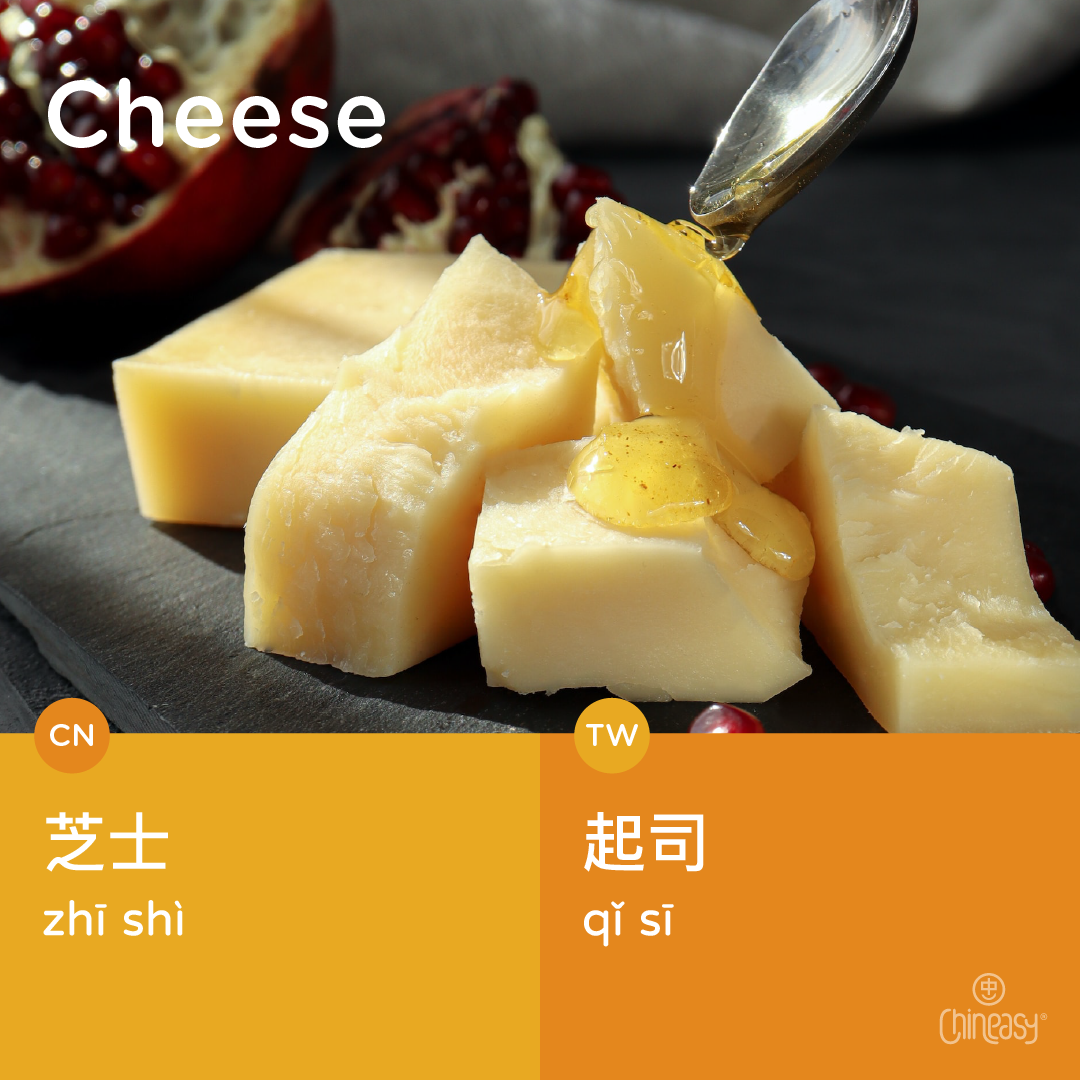
Cheese is becoming increasingly popular in both China and Taiwan, and each place has its own name for this Western food.
In China, people call it 芝士 (zhī shì), while in Taiwan, it’s known as 起司 (qǐ sī) or 起士 (qǐ shì). Although the terms are different, they all mimic the English word “cheese” in their pronunciation.
Not traditionally part of the Chinese or Taiwanese diet, cheese is now winning over many, especially young folks. They like adding it to pizzas and sandwiches and savoring it in desserts like cheesecake.
Tomato: 西紅柿/西红柿 in China and 番茄 in Taiwan
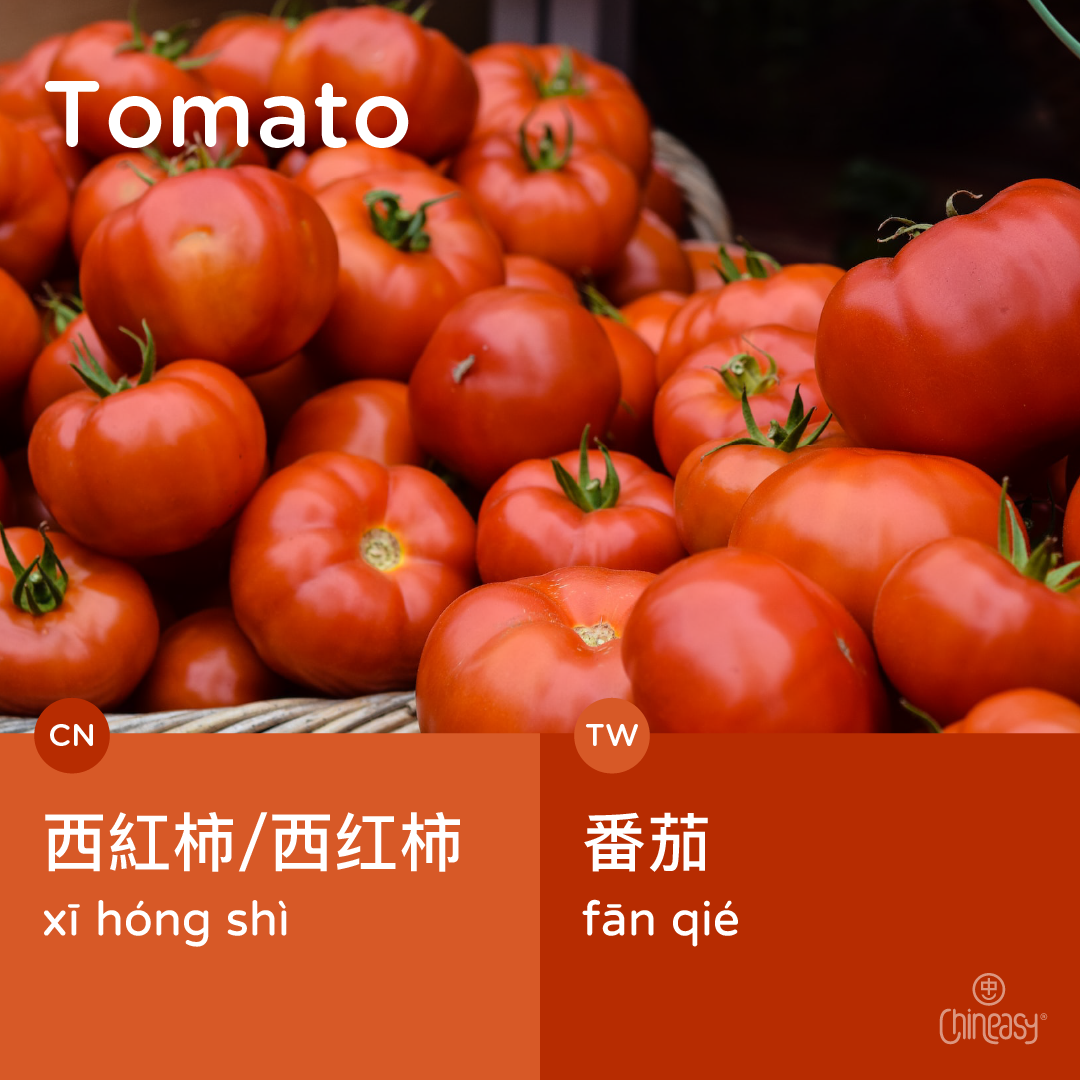
Talking about cheese, we can’t help but mention the tomato, as it certainly complements cheese wonderfully. Whether in a hearty Italian pasta or a cheese and tomato sandwich, tomatoes and cheese are a classic pairing.
In China, tomato is called 西紅柿/西红柿 (xī hóng shì), with 西 meaning “west,” 紅/红 meaning “red,” and 柿 meaning “persimmon.” This name possibly reflects the fruit’s introduction from the West and its red color, akin to that of a ripe persimmon.
In Taiwan, however, the name for tomato is 番茄 (fān qié), where 番 describes something “foreign,” and 茄, derived from 茄子 (eggplant; qié zi), due to the similarity in appearance. This highlights the tomato’s exotic origins and its botanical kinship to other nightshades like the eggplant.
In both China and Taiwan, tomatoes feature in a multitude of dishes. For instance, 西紅柿炒雞蛋/西红柿炒鸡蛋 (xī hóng shì chǎo jī dàn), or “tomato and egg stir-fry,” is a beloved home-cooked staple by many Chinese.
In Taiwan, 番茄牛肉湯麵/番茄牛肉汤面 (fān qié niú ròu tāng miàn), which is “tomato beef noodle soup,” stands out as a culinary must-try.
These dishes showcase the tomato’s universal appeal and its integral role in the comfort foods of both regions.
Salmon: 三文魚/三文鱼 in China and 鮭魚/鲑鱼 in Taiwan
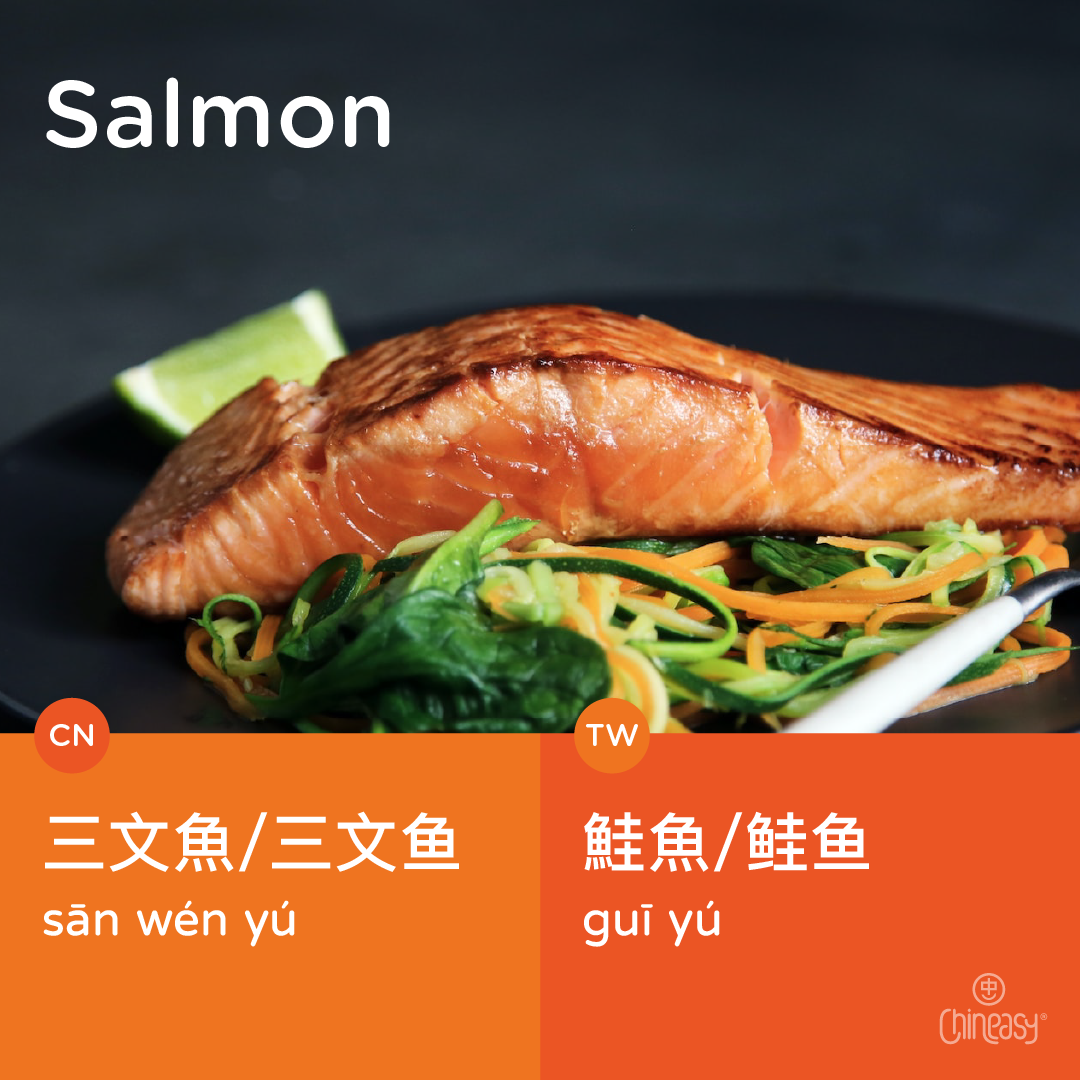
Tomatoes and salmon form an excellent combination, particularly when the salmon is baked. The tender, flavorful salmon pairs well with the juicy, tangy tomatoes, creating a popular culinary duo.
In China, the fish is known as 三文魚/三文鱼 (sān wén yú). Here, 三文 (sān wén) echoes the sound of “salmon” in English, and 魚/鱼 (yú) means “fish.” In Taiwan, it’s called 鮭魚/鲑鱼 (guī yú). Both names feature the key character 魚/鱼 (fish; yú).
Salmon is highly valued in Chinese and Taiwanese cuisine, commonly enjoyed thinly sliced on sushi, baked with tasty toppings like cheese, or crafted into tender fish balls, all of which highlight its delicate texture and rich flavor.
Broccoli: 西蘭花/西兰花 in China vs 青花菜 in Taiwan
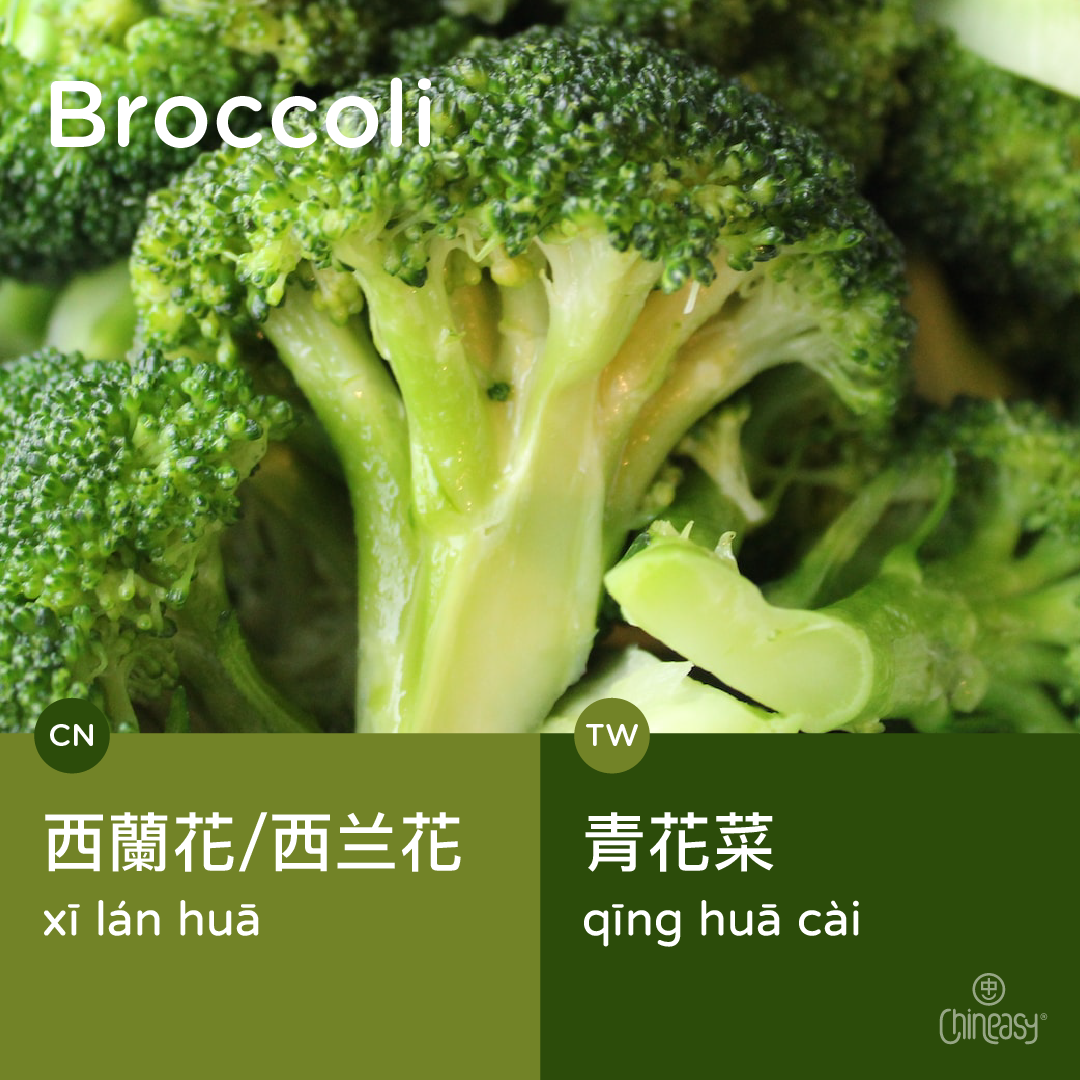
As we wrap up our exploration of food names, we shouldn’t overlook the importance of fiber in our diet. Broccoli is one of those nutrient-rich vegetables that should be on our radar.
In China, broccoli is called 西蘭花/西兰花 (xī lán huā), which means “western orchid flower,” suggesting its non-native status and its resemblance to a flowering plant.
On the other hand, in Taiwan, broccoli goes by the name 青花菜 (qīng huā cài), translating to “green flower vegetable,” a reference to its vibrant green color and flowery shape.
Broccoli is a popular ingredient used in a variety of Chinese stir-fry dishes. For instance, 牛肉炒西蘭花/牛肉炒西兰花 (niúròu chǎo xī lán huā) is a classic “beef and broccoli stir-fry” that combines the rich flavors of beef with the crunchy freshness of broccoli.
In Taiwan, a homestyle favorite is 青花菜炒薑絲/青花菜炒姜丝 (qīng huā cài chǎo jiāng sī), which features “stir-fried broccoli with thin strips of ginger,” highlighting the vegetable’s ability to absorb and complement the aromatic flavors of ginger.
And there you have it – a handy guide to 10 culinary terms that showcase the delightful variations between Chinese Mandarin and Taiwanese Mandarin. Whether you’re honing your Mandarin skills or exploring the subtleties of regional dialects, these insights will not only enhance your dialogues with native speakers from both places but also elevate your dining experience in Chinese and Taiwanese restaurants.
Knowing these distinctive expressions is a valuable addition to your linguistic repertoire and a nod to the rich cultural nuances that flavor every language.

